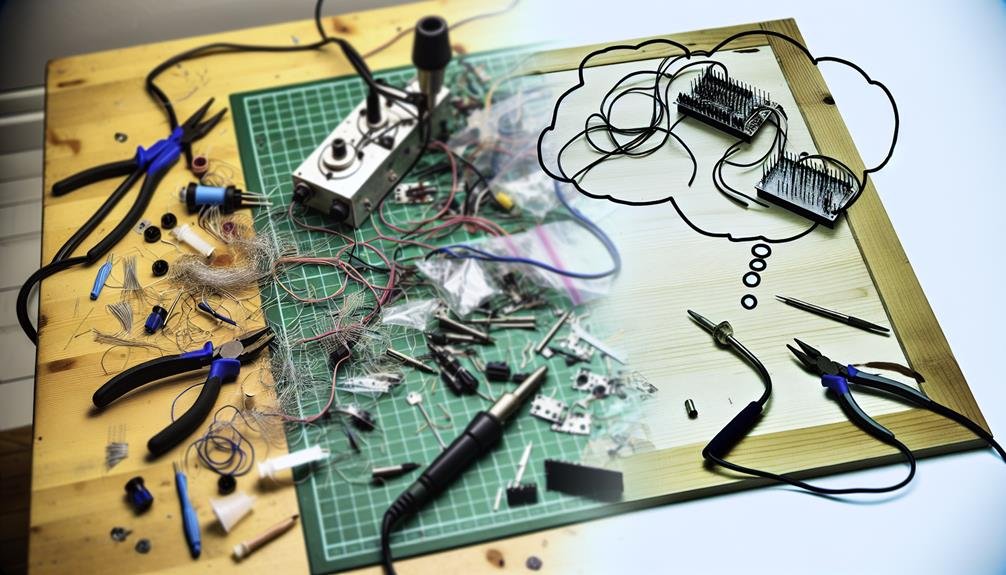Have you ever wondered if it's truly worth the effort to assemble your own electronics kit, or if it's simply easier to purchase a pre-assembled product?
The debate between DIY electronics kits and pre-assembled products has been ongoing, with enthusiasts on both sides passionately defending their preferences.
In this discussion, we will explore the various factors that can determine which option is better for you, including cost-effectiveness, learning experience, customization options, time and effort required, and quality and reliability.
So, whether you're a seasoned electronics enthusiast or just starting out, this discussion will shed light on the pros and cons of each option, helping you make an informed decision for your next project.
Key Takeaways
- DIY electronics kits offer significant cost savings compared to pre-assembled products, as they eliminate the cost of labor and only require payment for materials and components.
- DIY electronics kits provide a hands-on learning experience and skill development opportunity in electronics, allowing for practical skills acquisition, problem-solving, and critical thinking.
- DIY electronics kits allow for customization and personalization, giving individuals the freedom to personalize components, choose their preferred components, and customize software and programming options.
- DIY electronics kits require more time and effort for assembly and troubleshooting compared to pre-assembled products, but offer higher customization options and flexibility. However, pre-assembled products generally have an advantage in terms of durability and reliability.
Cost-effectiveness
When considering cost-effectiveness, it's important to evaluate the financial benefits of DIY electronics kits compared to pre-assembled products.
DIY electronics kits offer significant cost savings compared to pre-assembled products. By assembling the electronics yourself, you eliminate the cost of labor that's included in pre-assembled products. This means that you only pay for the materials and components, resulting in substantial savings.
Additionally, DIY electronics kits often come with detailed instructions, allowing you to learn and develop your skills in electronics. This knowledge can be valuable in the long run, as it empowers you to troubleshoot and repair your own devices, saving you money on repairs and replacements.
Furthermore, DIY electronics kits offer the flexibility to customize and modify the product according to your specific needs and preferences. This can lead to long-term benefits, as you have the freedom to adapt the product as technology evolves or your requirements change.
Ultimately, the cost savings and long-term benefits of DIY electronics kits make them a compelling choice for individuals who desire both financial freedom and the ability to tailor their electronics to their unique needs.
Learning Experience
To gain a comprehensive learning experience, DIY electronics kits provide a hands-on approach that allows you to actively engage in the assembly and understanding of electronic components. This hands-on approach is crucial for practical skills acquisition in the field of electronics. By physically connecting wires, soldering components, and troubleshooting circuitry, you develop a deeper understanding of how electronic devices function.
One of the key advantages of DIY electronics kits is the hands-on experience they offer. Unlike pre-assembled products, where you simply use the finished device, DIY kits require you to actively participate in the construction process. This allows you to gain practical skills and knowledge that are essential for becoming proficient in electronics.
By working with DIY electronics kits, you have the opportunity to learn through trial and error. This process encourages problem-solving skills and critical thinking as you troubleshoot and fix any issues that may arise during assembly. Additionally, DIY kits often come with detailed instructions and explanations, further enhancing your understanding of electronic components and circuits.
To illustrate the differences between DIY electronics kits and pre-assembled products, consider the following table:
| DIY Electronics Kits | Pre-Assembled Products |
|---|---|
| Hands-on Approach | Passive Experience |
| Develop Practical Skills | Limited Learning Opportunity |
| Trial and Error Learning | No Assembly Required |
Customization Options
Customization options allow individuals to tailor DIY electronics kits to meet their specific needs and preferences. One of the main advantages of DIY kits is the ability to personalize and modify the components according to your requirements. With pre-assembled products, you're limited to the features and specifications that are already built-in. However, with DIY kits, you have the freedom to choose the components and customize them to suit your preferences. This level of customization empowers you to create unique and personalized electronic devices that cater to your specific needs.
The personalization benefits of DIY electronics kits extend beyond just the physical components. Many kits also provide software and programming options that allow you to customize the functionality of your device. This means you can create a device that performs specific tasks or functions exactly the way you want it to. Whether it's adjusting the settings, adding new features, or integrating it with other devices, the customization options in DIY kits give you the freedom to make your device truly your own.
Moreover, customization options also foster creativity and innovation. By encouraging users to explore and experiment with different components and configurations, DIY kits provide a platform for learning and discovery. It allows individuals to gain a deeper understanding of electronics and encourages them to think outside the box. The ability to customize and personalize electronics kits not only enhances the user experience but also opens up new possibilities and opportunities for innovation.
Time and Effort Required
One consideration when comparing DIY electronics kits and pre-assembled products is the amount of time and effort required for each option. DIY electronics kits typically require more time and effort as they involve assembling the components and soldering them together. This process requires some level of soldering skills and troubleshooting techniques. On the other hand, pre-assembled products come ready to use out of the box, saving you time and effort.
To better understand the time and effort required for each option, let's compare them side by side in the table below:
| Aspect | DIY Electronics Kits | Pre-Assembled Products |
|---|---|---|
| Assembly Time | Can take several hours or even days depending on complexity | Ready to use out of the box |
| Soldering Skills Required | Yes | No |
| Troubleshooting Techniques Needed | Yes | No |
| Learning Curve | Steeper | Minimal |
| Customization Options | High | Limited |
As shown in the table, DIY electronics kits require more time and effort due to the assembly process, soldering skills, and troubleshooting techniques involved. They also have a steeper learning curve compared to pre-assembled products. However, DIY kits offer more customization options, allowing you to tailor the product to your specific needs.
Ultimately, the choice between DIY electronics kits and pre-assembled products depends on your preferences, time availability, and level of expertise. If you enjoy the process of building and troubleshooting, and have the necessary skills and time, DIY kits can be a rewarding option. However, if you prefer a ready-to-use product with minimal effort, pre-assembled products are the way to go.
Quality and Reliability
When considering the comparison between DIY electronics kits and pre-assembled products, an important aspect to evaluate is the quality and reliability of each option. Both DIY kits and pre-assembled products can vary in terms of durability and performance.
In terms of durability, pre-assembled products generally have an advantage. These products are typically manufactured in controlled environments, using high-quality materials and precise assembly techniques. This ensures that the final product is sturdy and capable of withstanding regular use. On the other hand, DIY kits may have a higher risk of durability issues, as they rely on the user's ability to assemble the components correctly. If not assembled properly, the resulting device may be prone to damage or malfunction.
In terms of performance, both DIY kits and pre-assembled products can offer satisfactory results. Pre-assembled products, being professionally manufactured, are often optimized for performance and undergo rigorous testing before reaching the market. DIY kits, on the other hand, provide an opportunity for customization and learning. With careful assembly and proper component selection, DIY kits can achieve comparable performance to pre-assembled products.
Ultimately, the choice between DIY kits and pre-assembled products depends on your specific needs and preferences. If durability and ease of use are your primary concerns, pre-assembled products may be the better option. However, if you enjoy the process of building and customizing electronics, and are willing to invest time and effort into ensuring proper assembly, a DIY kit can provide a rewarding experience while still delivering satisfactory performance.






